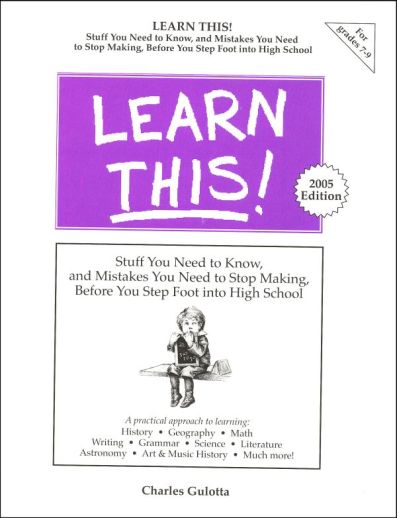We use cookies to make your experience better. To comply with the new e-Privacy directive, we need to ask for your consent to set the cookies. Learn more.
Learn This!
An excellent resource! This book was designed especially for students before they begin high school. The subtitle is "Stuff You Need to Know, and Mistakes You Need to Stop Making, Before You Step Foot into High School." It's an awesome book designed to ensure students know some relatively basic facts before they hit high school. For example, they should know the order of the planets, most of the more familiar presidents (although if they want to learn them all, they can do that here too), a basic timeline of world and U.S. events, how to find the diameter, radius and circumference of a circle, how to make subjects and verbs agree in sentences, at least five major artists and musicians, and the most famous works of some of the most famous authors in history. It sounds like a lot of information - and it is - but this book is in no way overwhelming. It is very non-threatening, with only about 70 pages including the introduction and other informational pages. The size isn't the only thing that is non-threatening -the text is written in very personable, often entertaining style from an author who doesn't want to bore students or surround them with long definitions, but really wants them to learn the basics to create a good foundation for their more advanced schooling. He speaks not in a know-it-all tone, but in a this-is-great-stuff-to-know manner. The book starts at the very broadest of issues, the universe, and works its way down to the smaller things like individual topics and famous people. Each topic is usually presented on a two-page spread, although some (like World History) take up a little more space. Here is a sampling of the spread and type of knowledge given on each topic, using the universe pages as an example. A column on the left side of the pages gives a brief overview to what we can know about the universe, and then we move on to "stuff you should know about your universe." This section provides a basic yet in depth summary of the universe, with important terms in bold. These bolded terms are Earth, the Solar System, star, galaxy, Milky Way, cluster, and light year. Enough information is given to students about each of them to give them a basic knowledge and understanding, sufficient but not enough to write a research paper about. The right hand page covers constellations, good terms to know such as black holes, nebula, and supernova, and finally a small section titled "Don't Make These Mistakes Anymore!" which tells students the difference between astronomy and astrology, what exactly a light year is (it is not a measure of time, but a distance), that the Earth and other planets revolve around the sun, which moves with the entire galaxy as it turns and moves through space, and what exactly an astronomical unit is. This same format (although it varies by topic) is used throughout the book to provide students with an excellent base for further learning. I know this is kind of a long list, but I want you to be able to see how complete this book actually is, so here is the table of contents: the Universe, the Solar System, Earth, Continents and Oceans, Countries and Cities, Islands and Mountains, Lakes and Rivers, U.S. Geography, Canadian Geography, World History, American History, U.S. Presidents, Canadian History, Math, Science, Writing and Grammar, Art and Music History, Literature, Major Religions, Languages, People, and Life and Miscellaneous. I think every pre-highschooler should definitely have access to and read a copy of this book, as well as any high school student or even beyond who would enjoy keeping a copy of the basics around. By the same author as 500 Keywords for the SAT, and How to Remember Them Forever and 100 Math Tips for the SAT, and How to Master Them Now! - Melissa
| Product Format: | Softcover Book |
|---|---|
| Brand: | Mostly Bright Ideas |
| Grades: | 7-9 |
| ISBN: | 9780965326353 |
| Length in Inches: | 10.75 |
| Width in Inches: | 8.5 |
| Height in Inches: | 0.25 |
| Weight in Pounds: | 0.45 |

